You’ve Never Seen an Interstellar Comet Look This Awesome
![]()
A few weeks after the Hubble Space Telescope captured an incredible photo of comet 3I/ATLAS as it screamed through the solar system at a blistering 130,000 miles per hour (209,000 kilometers per hour), the Gemini Multi-Object Spectrograph (GMOS) on Gemini South in Chile set its sights on the comet, capturing a gorgeous, colorful photo unlike anything seen before.
Researchers captured the new image on August 27, 2025, at Cerro Pachón, Chile, as part of the National Science Foundation (NSF) and Shadow the Scientists‘ public outreach initiative to help people get more engaged with science and astronomy. The scientific program to capture the comet was led by Karen Meech, an astronomer at the University of Hawaii’s Institute for Astronomy.
The stunning shot of comet 3I/ATLAS shows its prominent tail and brightly glowing coma, which is a cloud of gas and dust that grows as the comet gets closer to the Sun. The tail spans 1/120th of a degree in the sky, NOIRLab explains, “where one degree is about the width of a pinky finger on an outstretched arm.” The tail is longer now than it was in earlier photos of the comet.
Although part of the image capture session was to engage students, including from Hawai’i and La Serena, Chile, in exciting scientific research, during which the students could ask questions and follow the observations in real time, the scientists were also aiming to study the comet’s spectrum, or the wavelengths of light that it emits. Spectral information can provide key insights into an object’s chemical composition, and learning how it changes over time helps scientists understand a comet’s evolution as it flies through the solar system.

Comet 3I/ATLAS was detected on July 1, 2025, and given its speed, scientists determined that it arrived from outside the solar system. However, the spectral observations suggest that its composition is very similar to comets that originate in the solar system, suggesting that comets form from similar components and by consistent mechanisms in different planetary systems.
“The primary objectives of the observations were to look at the colors of the comet, which provide clues to the composition and sizes of the dust particles in the coma, and to take spectra for a direct measure of the chemistry,” says Meech. “We were excited to see the growth of the tail, suggesting a change in the particles from the previous Gemini images, and we got our first glimpse of the chemistry from the spectrum.”
Interstellar comets like 3I/ATLAS are exceptionally rare. The comet is only the third confirmed interstellar comet, joining comets discovered in 2017 and 2019. Comet 3I/ATLAS will head back into interstellar space thanks to its hyperbolic orbit, meaning it will avoid the fate of comets that originate in the solar system — getting too close to the Sun and dying.
![]()
“As 3I/ATLAS speeds back into the depths of interstellar space, this image is both a scientific milestone and a source of wonder,” says Meech. “It reminds us that our Solar System is just one part of a vast and dynamic galaxy — and that even the most fleeting visitors can leave a lasting impact.”
Image credits: International Gemini Observatory/NOIRLab/NSF/AURA/Shadow the Scientist
Image Processing: J. Miller & M. Rodriguez (International Gemini Observatory/NSF NOIRLab), T.A. Rector (University of Alaska Anchorage/NSF NOIRLab), M. Zamani (NSF NOIRLab)